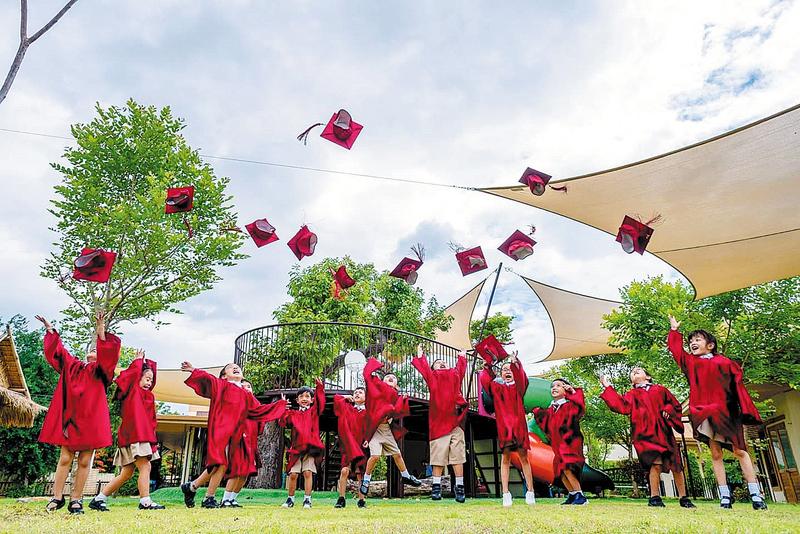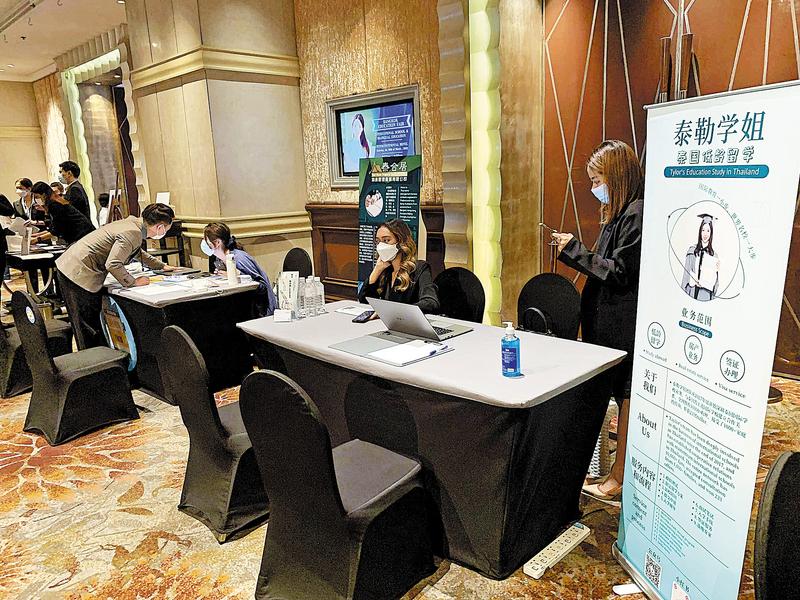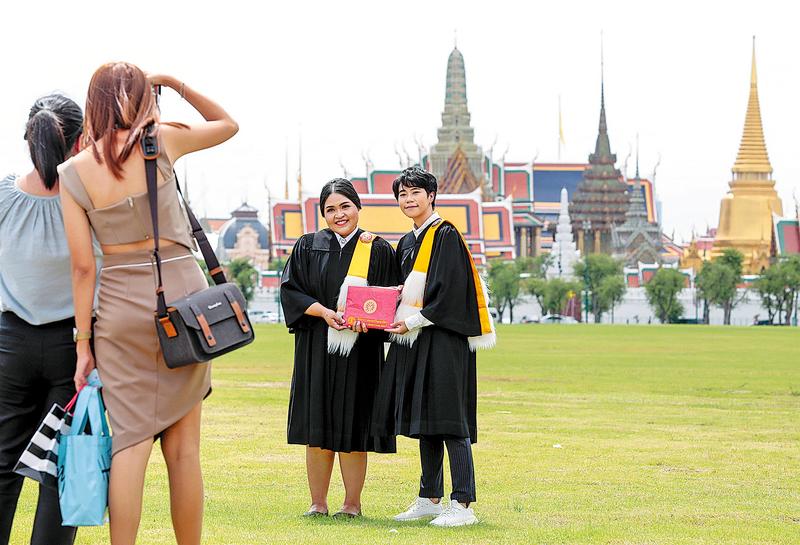Singapore and Thailand among several popular destinations
 Primary school students, including Gu Keyu's daughter, fourth right, celebrate the end of the summer term in Chiang Mai, Thailand, in June 2019. (PHOTO PROVIDED TO CHINA DAILY)
Primary school students, including Gu Keyu's daughter, fourth right, celebrate the end of the summer term in Chiang Mai, Thailand, in June 2019. (PHOTO PROVIDED TO CHINA DAILY)
A growing number of Chinese students are studying elsewhere in Asia — attracted by high-quality education, comfortable living conditions and relatively lower costs compared with Western nations.
Due to promotion of the Belt and Road Initiative, and rapid economic development in the region, more students from China are reconsidering their overseas study destinations.
By 2015, the total number of students exchanged between China and member states of the Association of Southeast Asian Nations exceeded 190,000. Some 120,000 of the students from China were mostly studying in Singapore, Thailand, Indonesia and Vietnam, according to the ASEAN-China Centre.
The growth of quality education in the region is the main attraction for Chinese students.
According to the newly released QS World University Rankings 2022, more than 10 universities in Asian countries (excluding China) are listed in the top 100, led by National University of Singapore in 11th place, and Nanyang Technological University, also in Singapore, in 12th place.
For 28-year-old Zhang Mila, applying to take a master's in science communication at NUS in 2016 was the first time she had taken a big decision about her life. Zhang, who was born in Longyan, Fujian province, graduated from the University of Macau with a bachelor's in social sciences in communication.
"I spent two months in the summer of 2016 thinking about the destination for my postgraduate studies. Despite receiving offers from universities in the United Kingdom and Australia, I eventually chose Singapore because of its high standard of education and tropical climate," Zhang said.
As the only Chinese student in the faculty, she experienced some hard times, and started to doubt if she could survive high-pressure overseas studies in Singapore.
"Although I became used to the English teaching curriculum in my undergraduate studies, I struggled at the start of my post-graduate course to understand the accents of Singapore English, and with the high standard required for professional writing," Zhang said.
However, she released her academic pressure through fencing, a sport she first took up as a freshman in undergraduate school. She joined the fencing team at NUS, took part in competitions, and made good friends through a variety of social activities.
After conquering her difficulties, Zhang eventually became more open-minded and tougher.
"The diversified curriculum might not help me in my future career, but it expanded my horizons and knowledge by enabling me to gain a broader understanding of the world. I am now more willing to absorb knowledge in various respects," Zhang said.
She added that due to Singapore's multicultural environment, she became more tolerant and willing to accept differences when she met people from diverse cultural backgrounds.
 Nanyang Technological University in Singapore is among educational institutions in Southeast Asia attracting students from the Chinese mainland. (LU PENGYU / FOR CHINA DAILY)
Nanyang Technological University in Singapore is among educational institutions in Southeast Asia attracting students from the Chinese mainland. (LU PENGYU / FOR CHINA DAILY)
Zhang said the number of Chinese students in Singapore has continued to rise since she arrived, especially after the COVID-19 pandemic emerged in 2020.
"I suggest that prospective students think clearly about their futures and their biggest concerns in studying abroad. If they want to broaden their world view and stay close to China geographically with fewer cultural differences, Singapore might be a good option," said Zhang, who works as a researcher in a national institute in the city state — her first job since she graduated from NUS in 2018.
As of the end of April, there were some 65,400 international students in Singapore, up by about 10 percent year-on-year, according to that nation's Ministry of Education and the Immigration and Checkpoints Authority, or ICA.
The 2021 Report on Chinese Students' Overseas Studies, released by Industrial and Commercial Bank of China, shows that the proportion of Chinese students interested in studying in Singapore has risen from 9 percent to 12 percent in the past three years.
Good reputation
Guo Qing, vice-president of Kewo Education, said, "Singapore's education system is known for its quality. This has brought strong demand from Chinese parents, who in the past decade — especially since 2019 — have turned to us for suggestions on how their children can acquire the qualifications to enroll at better Singapore schools."
Kewo Education, which is based in Singapore, helps students prepare for overseas studies with its one-stop services, including training courses for a variety of English proficiency examinations and academic tests.
At the end of 2017, ICA lowered the requirements for foreign students studying in Singapore, allowing all international students to apply, instead of only those holding work visas.
Kewo Education advocates Singapore as its top destination for overseas studies, ahead of the United States and the UK. Singapore has proved a wise choice, especially since the pandemic emerged globally in 2020.
In July that year, Singapore universities announced new plans for students accepted by overseas universities, but who were facing uncertainty due to lockdowns, visa delays and travel bans in most Western countries.
 Kewo Education holds a summer camp in Nanjing, Jiangsu province, in 2019 for Chinese students preparing for an admissions exercise to study at secondary schools in Singapore. (PHOTO PROVIDED TO CHINA DAILY)
Kewo Education holds a summer camp in Nanjing, Jiangsu province, in 2019 for Chinese students preparing for an admissions exercise to study at secondary schools in Singapore. (PHOTO PROVIDED TO CHINA DAILY)
Guo said many overseas study agencies for students majoring in the US and the UK were hit hard by the pandemic due to visa restrictions, but Kewo Education saw huge growth in demand for studies in Singapore.
In July last year, the Central Committee of the Communist Party of China and the State Council jointly issued Opinions on Further Reducing the Burden of Homework and Off-Campus Training for Compulsory Education Students, commonly known as the Double Reduction Plan. This top-level document aims to reduce the educational burden on Chinese school students, improve the quality of education in schools, and promote educational equality.
The term neijuan, which translates as "involution", has emerged as a reference to the fierce competition in the labor market and education system. The term is central to the debate over China's ultra-competitive culture.
Gao said, "Parents born after 1980 are more aware of the importance of international education and the urgent need to stand out amid fierce competition. They are looking to Singapore for their children to have a better chance of entering the world's top universities, and obtaining improved job opportunities."
Chinese students are now applying earlier for studies in Singapore because their parents want them to take courses with instruction in English at a younger age.
To meet increasing demands from parents of young children, Kewo Education introduced a series of preparatory courses for the Admissions Exercise for International Students, or AEIS, to China in 2014 for students hoping to study at Singapore's mainstream primary or secondary schools.
Over the past 13 years, more than 6,000 students have taken up Kewo Education's services and courses, and the company has helped 2,063 students pass the AEIS to enroll at government-run primary or middle schools.
"We're keen to relieve anxiety among Chinese parents who expect their children to work hard and receive a quality education in Singapore with our professional support through training courses and consultation services," Guo said.
 Staff members from Taylor Education attend an international education event in Thailand in April. (PHOTO PROVIDED TO CHINA DAILY)
Staff members from Taylor Education attend an international education event in Thailand in April. (PHOTO PROVIDED TO CHINA DAILY)
Growing potential
In addition to Singapore, Thailand is attracting more Chinese students for further education. According to Reuters, 8,455 Chinese students were enrolled at Thai colleges and universities in 2017, a rise of 100 percent compared with 2012.
However, in the past five years more students have studied at Thai primary schools or kindergartens in local international schools.
Song Yuwei, 36, the founder of Taylor Education, a service agency based in Thailand specializing in overseas studies, said, "In the past five years, we have received inquiries from more than 3,000 families annually. Over 300 of them eventually decided to enroll their kids, aged from 4 to 17, at international schools in Thailand."
Graduating in 2017 from York University in the UK with a master's in global marketing, Song arrived in Thailand to explore the property market. She worked at a property developer in China before going to the UK, but saw growing potential for the Thai market after receiving inquiries from homebuyers about educating their children in Thailand.
In the past five years, she has visited nearly all the major international schools in Thailand. Song found that the education offered is better developed than elsewhere, with more experienced teachers who are native English speakers, and tuition that is cheaper than at international schools of the same level in China.
Song plans to send her 6-year-old son to an international school in Bangkok next year.
A Taylor Education marketing and consulting team is visiting China to help clients prepare their children for overseas studies, while the company's staff members in Thailand are responsible for local life services, including translation and renting accommodations.
Most of Song's clients are parents of children in the 4 to 10 age group, who are studying at kindergarten or primary school.
"In deciding for your child to receive an international education, it is always a case of the earlier the better, to allow the child to acquire a second or even a third language more easily," Song said.
She added that 95 percent of her clients use Thailand as a "springboard" before sending their children to the US, the UK, Canada and other Western countries for higher education.
"With more members of the post-90s generation becoming parents, students may start studying abroad at a younger age and at more diversified destinations, as their highly educated parents want them to develop independent personalities and fulfill their dreams, instead of gaining success solely through exam scores," Song said.
 Students pose for photos ahead of their graduation ceremony at Thammasat University in Bangkok, Thailand, in 2020. (SUNTI TEAPIA / AP)
Students pose for photos ahead of their graduation ceremony at Thammasat University in Bangkok, Thailand, in 2020. (SUNTI TEAPIA / AP)
Gu Keyu, 33, who comes from Kunming, Yunnan province, and is the mother of an 8-year-old girl, decided to move to Chiang Mai, Thailand, in 2019 for her daughter to receive an international education.
"My husband and I were keen to offer more choice for our daughter, whose life at home seemed mainly to comprise studying and achieving better scores, leaving little time for her to play or develop her interests," she said.
Gu is impressed by Thailand's warm climate and friendly environment, where people frequently greet each other with a smile on the streets.
"Schoolwork here is not as difficult as it was in China, but the education system requires students to have all-around development in morality, intelligence, sports, arts and practical skills," Gu said.
In the past three years, her daughter has changed from being a shy child to a cheerful and confident young girl who is willing to express her opinions.
"I was touched to receive a sealed and confidential assessment about my daughter at the end of term, and to hear the principal say in a speech that the school wants to focus on students' progress compared with the previous year, and see how they have improved, rather than judge them by their final score," Gu said.
She added that she thinks it worthwhile spending 150,000 yuan ($20,550) a year to live in Thailand.
The relatively low cost of education in Southeast Asia is another factor attracting Chinese students, who typically spend two years on average in Thailand studying for a master's at a cost of about $31,000. In South Korea, the cost is about $16,000 per year, compared with the $50,000 it costs to study in the UK for a year and $100,000 in the US.
Lower costs were a key concern for Yu Yi, 45, the mother of an 18-year-old daughter from Wenzhou, Zhejiang province, after the teenager chose to study in the China-Korea international class in second grade at senior high school.
Her daughter is now studying at Sungkyunkwan University in Seoul, the South Korean capital, majoring in humanities. As a parent, Yu believes that studying abroad can make a big difference in developing a child's independence, compared with a college education in the home country.
"It will be easier for my daughter to enter a higher-ranking university anywhere in the world, as she is studying in South Korea, which may also broaden her vision, allow her to make new friends, become independent, and most important, increase her competitiveness in future employment," Yu said.
"She felt as though she had suddenly grown up when she had to do everything herself, from examining her body, to contacting the local taxi company to be picked up from the airport. She has also recently started cooking Chinese cuisine."
However, Yu suggests that if a family has sufficient financial resources, studying in countries such as the US and the UK is a better option.
"Although the culture, lifestyles and eating habits in South Korea are quite similar to those in China, the overall standard and recognition of overseas study in Europe and the US is higher than in Asia," she said.
Meanwhile, compared with the increasing popularity of Asian universities, fewer Chinese students are enrolling at those in the US.
The Open Doors 2021 report by the Institute of International Education shows that last year, the number of students from the Chinese mainland studying in the US fell by 14.8 percent year-on-year to 317,299.
Pan Jie, chief product officer at Liyuan Education, an overseas education consulting company based in Shenzhen, Guangdong province, said: "Chinese students have gradually taken to studying abroad as a regular option for higher education. This trend signals a redistribution of educational resources, while the study destinations are also becoming more diversified."
Contact the writer at sunnyu923@163.com


